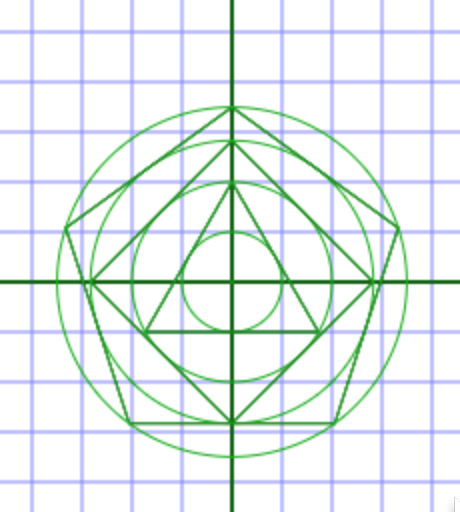Nested Polygons (1.0)

In the book The Joy of Mathematics by Theoni Pappas, the author talks about limits and infinity, citing (on page 180), an example of an alternating series of circles and regular polygons of monotonically increasing order, each circumscribed on the previous shape (as seen at right).
If the largest polygon is a pentagon, then the outer circle is slightly less than 3.5 times the innermost circle. She writes that, as number of sides in the polygon increases toward infinity, the outermost radius would approach a limit of 12 times that of the innermost circle.
This struck me as an odd value, and I set out to find out how this number 12 is derived. I started by checking to see if I could come up with an analytical solution. What I came up with was that the radius of the circle circumscribing the n-gon was:
 eq. 1
eq. 1
(assuming that innermost circle was of radius 1)
Since  then
then  should
be bounded. I was stumped on how to calculate it though.
should
be bounded. I was stumped on how to calculate it though.
So I developed a way to visualize and explore how the outer radius grows as the order of the outermost polygon goes up. Originally I did this as a Java Applet, but browsers stopped supporting java applets, so I redid it using an HTML canvas implementation with angular.js controls.
The selction menu at the end allows you to change the visualization. Since multiplying Secants can be represented graphically by contstructing right triangles on top of each other, this is a representation that shows how the product works. At high numbers, both the Polygon and Triagnle visualizations become cluttered, so I also allow you to see only the vertices of the triangles and how that spiral approaches a value slightly more than 8.7. I have taken the product out to 300,000,000 terms, and the calculated ratio of outermost triangle to innermost is 8.700036609454449, though that likely contains a fair bit of round-off error. It seems implausible that further terms would take it all the way to 12, but I doubt that a computer simulation would be able to calculate that with any degree of accuracy or precision.
Outer Radius: {{outerRadius}}
Max polygon size:
Drawing style:
There is also a way to explore even larger values.